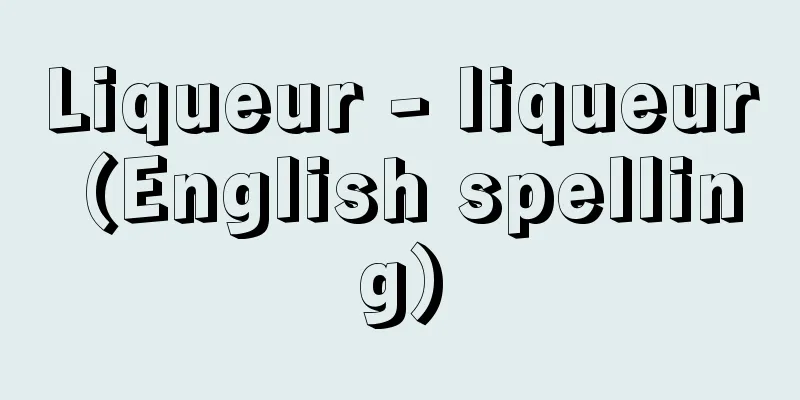Liqueur - liqueur (English spelling)

|
The word liqueur comes from the Latin liquor (liquid), which became the Old French word licur and then the modern liqueur. [Hara Masamichi] Classification and definitionIt is a strong, sweet alcoholic drink made by adding flavorings and colorings to brewed or distilled alcoholic drinks or pure alcoholic liquids, and has a distinctive aroma with the flavors of fruits, seeds, roots, bark, etc., and the sweetness of sugar. However, liqueurs as defined by Japan's Liquor Tax Act are made from processed alcoholic drinks, sugar, flavorings, and colorings, and have an alcohol content of 15% or more and an extract content of 2% or more. However, this does not include sake, synthetic sake, shochu, mirin, beer, fruit liquors, whiskey, and happoshu. In France, liqueurs are divided into "ordinaires," "fines," and "surfines," with the finest varieties being "crèmes" and "elixirs." This classification is based on alcohol content and sugar content. For example, fines require 24.5% alcohol and 40-50% sugar, while fines have 26.5% alcohol and 45-50% sugar, and have a stronger aroma. In the UK and the US, liqueurs are called cordials, which comes from the Latin cordialis (medicine). In the US, liqueurs must contain more than 2.5% sugar or glucose in the final product, and must not contain any synthetic or imitation flavorings. [Hara Masamichi] historyIn ancient times, there was a technique for making perfumes such as rose water, but as a drink, it was mostly created in European monasteries, and initially it was made using herbs as medicine. In the 13th century, liqueurs were made from orange blossoms, lemons, roses, etc. When the plague was widespread in Europe in the 14th century, liqueurs made from vegetable oils and tonics were like precious medicines. After that, through Italy, they were popular in the French court from around the 16th century, and were also produced as medicinal liquors in temples. In the 19th century, the foundations of today's liqueur industry were established, and many famous liqueurs were produced. In the 20th century, the drinking of cocktails increased, mainly in the United States, and liqueurs began to be drunk in new ways, which continues to this day. Meanwhile, in China, liqueurs have been made as medicinal liquors since ancient times, and the Shennong Bencao Jing (around the time of Christ), a classic of Chinese medicine, describes soaking medicine in liquor and drinking it. In addition, the 1596 edition of the Honmao Gangmoku lists 69 types of medicinal liquor. Medicinal liquor has a long history in Japan, and is said to have started with the toso liquor used at the Imperial Court during the Heian period. This liquor came from China and was created by Hua Tuo, a famous physician from the Later Han dynasty. [Hara Masamichi] How to make itThere are three ways to impart specific flavor components to liqueurs: (1) Infusion method: The flavoring substances are soaked in alcohol or brandy to extract the flavor components. This method is mainly used for fruit and herbaceous ingredients. (2) Distillation The extract obtained by the leaching method is distilled, and the flavor components are extracted together with alcohol into the distillate. (3) Essence method: Natural or synthetic essential oils and other flavoring ingredients are prepared in the form of an essence. To prepare the flavor liquid, alcohol, brandy, rum, or other alcoholic beverages, flavoring substances such as sugar, colorings, and water are added, and the liquid is aged for a short period of time before being clarified, filtered, and bottled. Alcoholic beverages that can be used include gin, kirsch, vodka, wine, and whiskey. [Hara Masamichi] Types and FeaturesThere are many types of liqueurs, and their ingredients vary, but generally they are sweet and have a unique aroma with an alcohol content of 25-50% and an extract content of 25-50%. Liqueurs can be categorized by ingredients into fruit-based (using fruits such as cherries), peel-based (using citrus peels), seed-based (using caraway seeds, etc.), herbaceous (using the roots, stems, leaves, and buds of various aromatic plants), floral (adding floral flavors), and emulsified (using emulsified products), and there are many types, and each company has its own method for blending the flavoring substances. [Hara Masamichi] How to drinkLiqueurs generally have a high alcohol and sugar content, so rather than drinking them straight, they are drunk in small amounts as an aperitif to stimulate the appetite or as an after-meal drink to refresh the senses. They are also used in cocktails and confectionery. Umeshu (plum wine) is widely consumed at home as a homemade liqueur, and yakumishu (yakumi liquor) is consumed as a tonic. [Hara Masamichi] [References] | | | drink| | | | |©Shogakukan "> Main types of liqueurs (1) ©Shogakukan "> Main types of liqueurs (2) Source: Shogakukan Encyclopedia Nipponica About Encyclopedia Nipponica Information | Legend |
|
リキュールの語源はラテン語のリクオルliquor(液体)からきており、これが古代フランス語のlicurとなり、現在のliqueurに変化したものである。 [原 昌道] 分類・定義醸造酒や蒸留酒または純アルコール液に香料、色素を加えて香味づけをし、果実、種子、草根木皮などの風味と糖類の甘味を加えた特有の芳香がある、アルコール分の強い、甘い酒である。ただ、わが国の酒税法でいうリキュール類とは、製成された酒類と糖類、香味料、色素を原料とし、アルコール分が15%以上、エキス分が2%以上のものである。ただし、清酒、合成清酒、焼酎(しょうちゅう)、みりん、ビール、果実酒類、ウイスキー類、発泡酒に該当するものは除かれる。 フランスでは普通物ordinaires、上物fines、極上物surfinesとに分け、極上物にcrèmesとelixirsとがある。この区分はアルコール度数と糖分量による。たとえば上物は24.5%のアルコール分、40~50%の糖分を必要とし、極上物はアルコール分26.5%、糖分45~50%で香りも強くなっている。イギリス、アメリカではリキュールをコーディアルcordialという。これはラテン語コルディアーリスcordiālis(医薬)からきている。なお、アメリカのリキュールは、最終製品に2.5%以上の砂糖またはブドウ糖を含有していることと、合成香料、イミテーション香料は使用してはならないことになっている。 [原 昌道] 歴史古代にはバラ水のような香水をつくる技術があったが、飲み物としてはヨーロッパの修道院で創製されたものが多く、初めは医薬として薬草を用いたものである。13世紀にはオレンジの花、レモン、バラなどからリキュールがつくられた。14世紀にヨーロッパでペストが大流行した際には、植物性の香油や強壮剤を用いたリキュールは宝物のような薬であった。その後イタリアを経て16世紀ころからフランスの宮廷を中心にもてはやされ、一方では薬酒として寺院などで製造された。19世紀には今日のリキュール産業の基礎ができあがり、多くの著名なリキュールが生み出された。20世紀にはアメリカを中心としてカクテルの飲用が高まり、リキュールは新しい飲み方をされるようになり今日に至っている。一方、中国ではリキュールは薬酒として古くからつくられており、漢方の古典といわれる『神農本草経(しんのうほんぞうきょう)』(西暦紀元前後)に、薬を酒に浸して飲むことが記されている。また1596年に出された『本草綱目』のなかには、69種の薬酒が載っている。わが国でも薬酒の歴史は古く、平安時代に宮中で用いられた屠蘇(とそ)酒が初めだといわれる。この酒は中国からきたもので、後漢(ごかん)の名医華陀(かだ)の創作である。 [原 昌道] 作り方リキュールに特有の香味成分をつける方法として次の三つがある。 (1)浸出法 香味物質をアルコールやブランデーに浸漬(しんし)し、香味成分を抽出する。果実や草本系の原料は主としてこの方法を用いる。 (2)蒸留法 浸出法で得られる浸出液を蒸留し、香味成分をアルコールとともに留液中に留出させる。 (3)エッセンス法 天然または合成の精油、そのほかの香味成分をエッセンスの形に調製したもの。 調合は、このようにしてつくられた香味液に、アルコール、ブランデー、ラムなどの酒類や、糖類などの呈味物質や色素、水などを加え、短期間熟成して、清澄、濾過(ろか)、瓶詰にする。酒類としてはジン、キルシュ、ウォツカ、ワイン、ウイスキーなども用いられる。 [原 昌道] 種類と特色リキュールは種類が非常に多く、成分もまちまちであるが、一般にアルコール分は25~50%、エキス分は25~50%で、甘くて、特有の香りがある。リキュールを原料別に分けると、果実系(サクランボなどの果実を使用する)、果皮系(柑橘(かんきつ)類の果皮を使用する)、種子系(キャラウェーの実などを使用する)、草本系(各種の芳香植物の根、茎、葉、つぼみを原料にする)、花系(花の香味をつける)、乳化系(乳化製品を使用する)などに分かれ、その種類は多く、また香料物質の配合では各社独自の方法がなされている。 [原 昌道] 飲み方リキュールは一般にアルコール分と糖分が強いので、ストレートで飲むよりは、食前酒として食欲増進用に、食後酒として清味用に少量飲まれる。そのほか、カクテル、製菓用にも使われる。梅酒はホームリキュールとして家庭で広く飲用されており、薬味酒は滋養強壮剤として飲まれている。 [原 昌道] [参照項目] | | | | | | | | |©Shogakukan"> リキュールのおもな種類(1) ©Shogakukan"> リキュールのおもな種類(2) 出典 小学館 日本大百科全書(ニッポニカ)日本大百科全書(ニッポニカ)について 情報 | 凡例 |
Recommend
Wind-pollinated flower - Fuubai-ka
This refers to flowers that are pollinated when p...
Metal Western-style tableware
...Population: 43,589 (1995). Famous for producin...
Relative contract - Aitai no keiyaku
...This refers to credit relationships that were ...
Presumptive defense - Kaiteikouben
...It differs from a denial in that the person as...
Dushanbe (English spelling)
The capital of Tajikistan. Dyushambe was the capit...
Rampant caries
This is one of the terms used to describe the cond...
Ursprache
…Linguistics is a science that deals with languag...
Kawachi Takaoka
?-? A government official and poet in the Nara pe...
Mamatekona - Mamanotekona
A beautiful girl who lived in Mama, Katsushika Cou...
Kahata - Kahata
...In Akita, they are called Kaminariuo (Thunderf...
Olympic Charter
This column lists the Fundamental Principles of O...
Ethyl acetoacetate (English spelling)
...These abnormal metabolic products are found in...
Public interest
The public interest literally means the public in...
Soyuzblagodenstviya (English notation) Soyuzblagodenstviya
From here, they formed an association in the hope...
Contract - Contract
A document made to promise a future action. It is...









